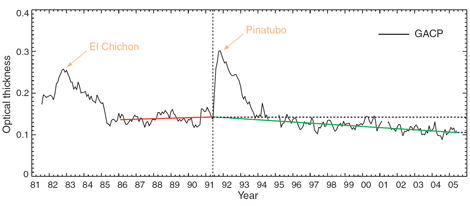Volume 10, Number 24: 13 June 2007
In a short but important paper, Mischenko et al. (2007) present a plot of the global monthly average of the column aerosol optical thickness (AOT) of the atmosphere that stretches from August 1981 to June 2005, which they developed from what they describe as "the longest uninterrupted record of global satellite estimates of the column AOT over the oceans, the Global Aerosol Climatology Project (GACP) record." This record, in turn, was derived from "the International Satellite Cloud Climatology Project (ISCCP) DX radiance data set," which is "composed of calibrated and sampled Advanced Very High Resolution Radiometer radiances."
As can be seen from our adaptation of the eight researchers' graphical results, which we have plotted in the figure below, "the green line," as they describe it, "reveals a long-term decreasing tendency in the tropospheric AOT," such that "the resulting decrease in the tropospheric AOT during the 14-year period [1991-2005] comes out to be 0.03." And they add that "this trend is significant at the 99% confidence level."
The GACP record of the globally averaged column AOT over the world's oceans. Adapted from Mischenko et al. (2007).
In discussing their results, Mischenko et al. note that "observations of downward solar radiation fluxes at earth's surface have shown a recovery from the previous decline known as global 'dimming', with the 'brightening' beginning around 1990." Their AOT record harmonizes with these observations, as well as with estimated trends in primary anthropogenic emissions of SO2 and black carbon, which they say are known to "contribute substantially to the global AOT."
These several facts raise serious questions about attributions of late-20th-century global warming to the concomitant increase in the atmosphere's CO2 concentration, for as noted by Stanhill (2007), the changes in the flux of solar radiation received at the surface of the earth as a consequence of the global dimming and brightening phenomena far exceed the changes in longwave radiative forcing produced by historical changes in the air's CO2 content; and these observations would appear to relegate anthropogenic CO2 emissions to a much less important role in terms of their ability to elicit significant changes in earth's surface temperature.
Unwilling to accept this conclusion, climate alarmists contend that recent global brightening is merely allowing CO2-induced global warming to become more evident, which enables them to contend that the CO2 greenhouse effect is actually much stronger than even they had originally believed, having been masked for some time by the cooling power of the prior buildup of the great aerosol load of the atmosphere. Consequently, we have proponents of CO2-induced global warming, such as Science magazine's Richard Kerr (2007), writing news items with titles that ask "Is a thinning haze unveiling the real global warming?" - when a better question to ask (or at least a reasonable alternative) might be "Is a thinning haze revealing its own great power to warm the earth?" Also, such writers seem to have no trouble finding scientists willing to cast doubt on what they perceive to be the disturbing implications of the unfolding aerosol work. In Kerr's case, the doubter is Sarah Doherty of the University of Washington, who says there's simply too much uncertainty in the aerosol data, and that the problem lies, in part, "in stringing together records from five different instruments flown on five different satellites over the years."
As if anticipating this attack, Mischenko et al. clearly state in their report that "the successful validation of GACP retrievals using precise sun photometer data taken from 1983 through 2004 indicates that the ISCCP radiance calibration is likely to be reliable," and they further note that "this conclusion is reinforced by the close correspondence of calculated and observed top of atmosphere solar fluxes." What is more, they say "the GACP AOT record appears to be self-consistent, with no drastic intra-satellite variations, and is consistent with the Stratospheric Aerosol and Gas Experiment record."
All things considered, the findings of Mischenko et al. do not bode well for the world's climate alarmists, who continue to claim that anthropogenic CO2 emissions have been the predominant source of global warming over the latter part of the 20th century; for there is now ample reason to believe that a significant portion of the observed warming may actually have been caused by the concomitant increase in surface heating provided by the atmosphere's declining aerosol optical thickness.
Sherwood, Keith and Craig Idso
References
Kerr, R.A. 2007. Is a thinning haze unveiling the real global warming? Science 315: 1480.
Mishchenko, M.I., Geogdzhayev, I.V., Rossow, W.B., Cairns, B., Carlson, B.E., Lacis, A.A., Liu, L. and Travis, L.D. 2007. Long-term satellite record reveals likely recent aerosol trend. Science 315: 1543.
Stanhill, G. 2007. A perspective on global warming, dimming, and brightening. EOS, Transactions, American Geophysical Union 88: 58.





